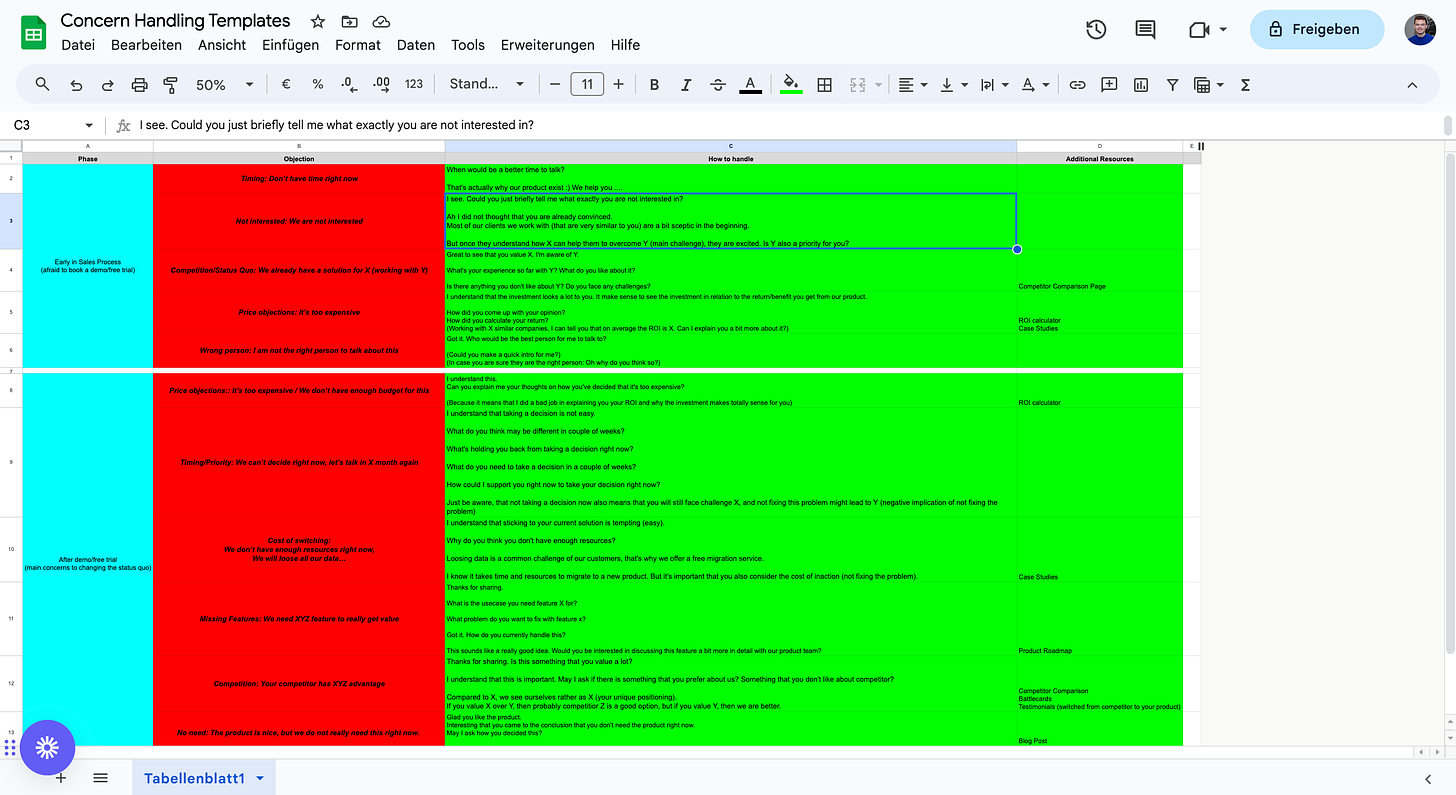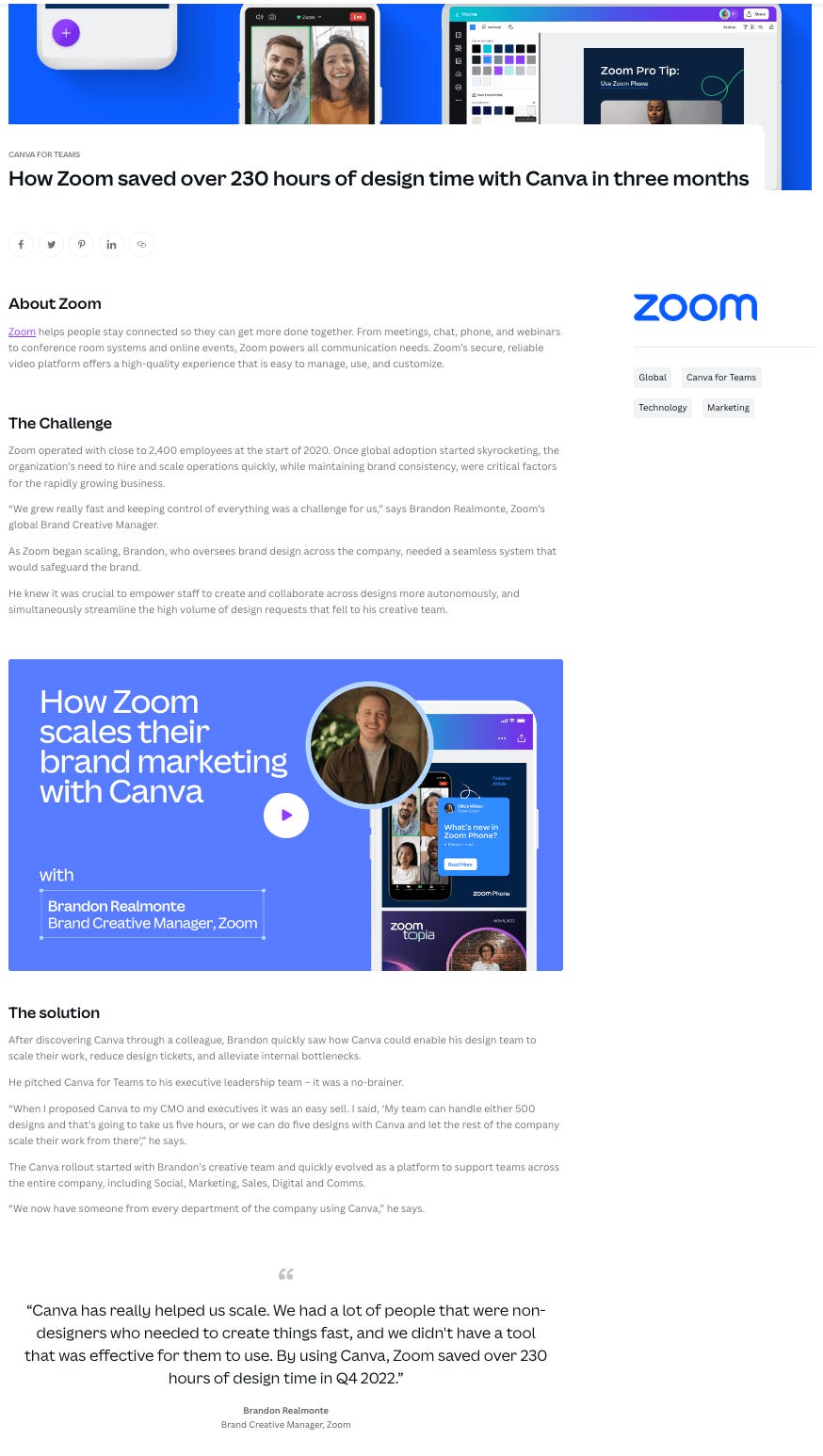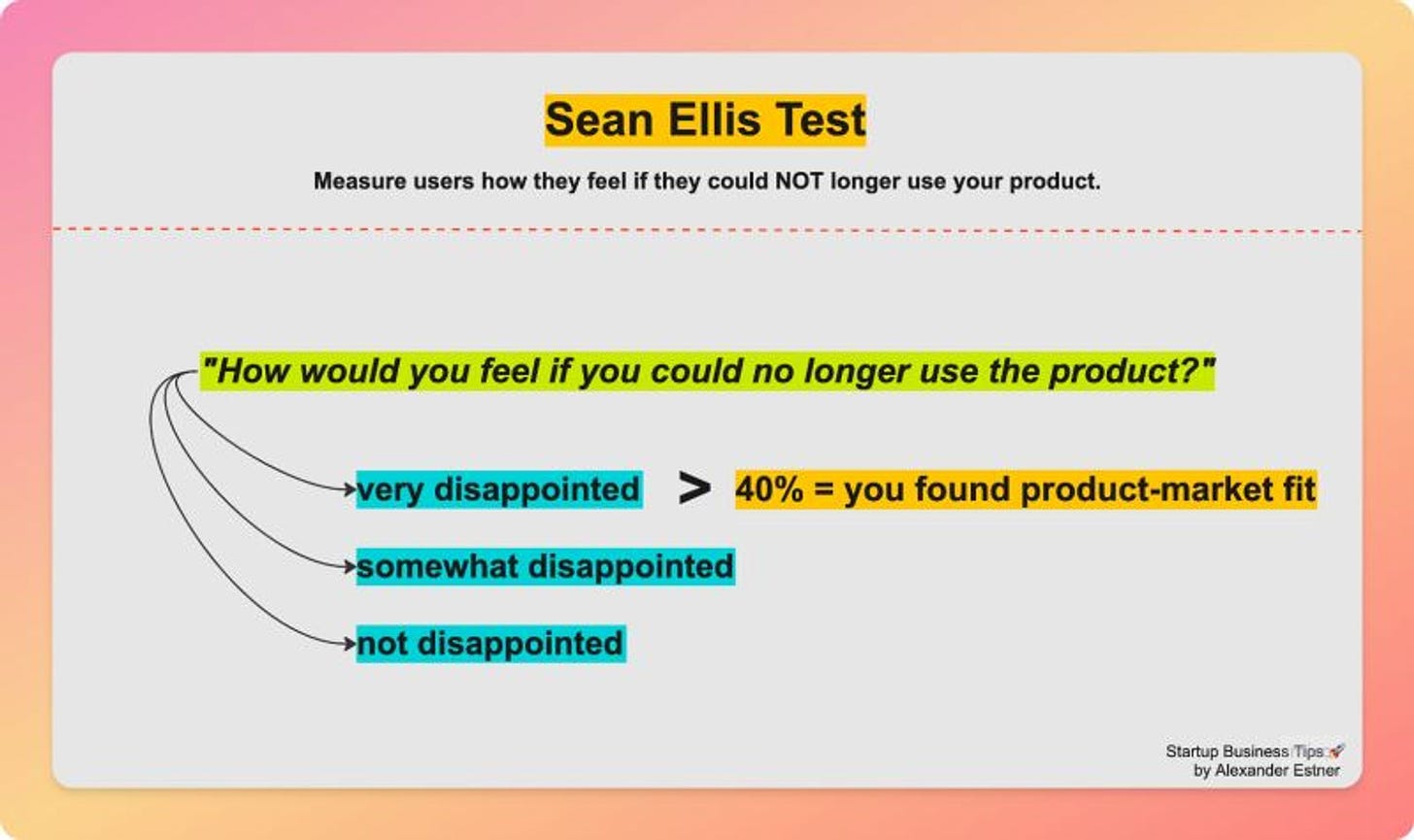How to handle top customer objections (Free template), create powerful case studies & measure product-market fit.
Hey - it’s Alex!
Today, I will share with you:
1️⃣ 3 Actionable SaaS growth tips
👉 How to handle concerns and objections (Concern-handling template)
👉 How to create powerful case studies
👉 Sean Ellis test to measure product-market fit
2️⃣ 1 Bonus tip by an experienced founder/VC/SaaS expert - this time by Marc Grewenig (Co-founder at Emlen)
3️⃣ 1 Bonus material (software, content, news) - this time How to craft a sales story that sells - by April Dunford
… that will help you quickly grow your SaaS product 🚀.
Want to reach 1400+ early-stage SaaS founders/leaders? Sponsor the next email.
👉 Before you read on:
✅ Create your own powerful SaaS Growth Strategy with my FREE Workbook (helped 2000+ SaaS professionals) and GTM-strategy 1-pager Notion template (helped 750+ SaaS professionals)
✅ Unlock your growth potential with 90+ actionable SaaS growth tactics (helped 150+ SaaS professionals)
✅ Work with me 1-on-1 in my 12-week SaaS GTM Coaching program for early-stage SaaS founders on their way to hitting the first €1 million ARR.
❤️ Get exclusive benefits for sharing my newsletter with your SaaS network (with your team members, Slack channels, Linkedin groups, online communities, or on Linkedin/Twitter).
1. Concern Handling (Template)
Every SaaS founder and sales professional working in B2B SaaS, will face a lot of objections and concerns from potential clients. Being prepared for the most common concerns help you to better handle them and ultimately close more deals.
That’s why I highly recommend creating your own Concern Handling Template .
A concern-handling document can be a very basic document with 3-4 columns:
The objection/concern
How to handle it
Additional resources
(Segmented by buyer journey/ stage in the sales process)
If you target different personas and ideal customer profiles, it makes sense to have versions for each target group.
Here is an easy-to-follow step-by-step guide on how to create your own version.
Step 1: Download my free Concern Handling Template (or create your own version)
Step 2: Gather the top 5 objections/concerns for each step of the sales process:
Beginning of sales process (Why they are afraid to start a free trial/book a demo):
Timing: Don’t have time right now
Not interested: We are not interested
Competition/Status Quo: We already have a solution for X
Price objections: It’s too expensive
Wrong person: I am not the right person to talk about this
After the sales demo (The main concerns not changing the status quo):
Price objections:: It’s too expensive / We don’t have enough budget for this
Timing/Priority: We can’t decide right now, let’s talk in X month again
Cost of switching: We don’t have enough resources right now, We will lose all our data…
Missing Features: We need XYZ feature to really get value
Competition: Your competitor has XYZ advantage
No need: The product is nice, but we do not really need this right now.
Step 3: Once you know the concern, learn how to best handle them.
When it comes to handling objections, try the following fundamental key principles:
listen actively - really listen. Don’t prepare already for your response.
don’t interrupt - let them tell you what they want to tell you.
don’t say it’s not true - show understanding of their situation.
don’t ignore - acknowledge the fact they have concerns.
show understanding, and be open for a conversation - be on the ‘same’ side to discuss openly the real issues.
work together with the client, not against them - Focus on helping and guiding them.
be interested and uncover the true concerns - ask good questions (Why, How, Who, etc.)
Of course, a good understanding of your product, the competition landscape, and industry insights help you as well here.
Step 4: Add ready-to-use responses and additional resources (for the true concerns).
The document needs to be a living document (frequently updated) to which all customer-facing teams (especially salespeople) need access. Once you added responses for each concern, the document can be a real assistant for you and your sales team (e.g. open it during cold calling and demos). I would recommend training your team on objection handling (e.g. during onboarding of new team members).
2. Case Studies & Testimonials
Social proof (case studies & testimonials) is a powerful tool to convince potential customers that your solution is effective and trustworthy. People like the fact that others (that are similar to them) do/use/trust the same.
Having great case studies and testimonials will increase your conversion rates. But creating them is not easy. That’s why I will share with you how to create powerful strong case studies.
Step 1: Analyze existing clients
First, you need to prioritize what kind of case study/testimonial you need. What segment/customer type/use case do you need? Filter your existing clients based on that.
Then only search for customers which:
high NPS score
< 6-month retention
high product usage
fits your Ideal customer profile (ICP)
Step 2: Outreach via Email/Phone
If you’re early-stage getting first testimonials is so important. So be fine with giving something in return (if needed). This could be a free upgrade, discount on the first year, free training, etc.
If you are >€ 1 million ARR, instead of giving discounts, sell the benefits of being one of your testimonials (it’s free marketing exposure for them).
Step 3: Interview the client (30min+) and prepare questions upfront
Create a document with 5+ questions and share it with the client upfront.
Questions can include:
What challenges did you face before working with X?
Why did you decide to search for a solution? Have you tried other solutions before X?
How did you find X?
What was your experience with X?
What changed since you implemented X in your company?
What do you want to achieve with X in the future?
Would you recommend X to others? If yes, why and to whom?
If possible, ask for permission to record the interview.
Step 4: Create different types of social proof from the interview
Ideally, you can create multiple assets from the interview. This could be a (short and long-form) video testimonial, a written case study, and quotes.
For the (written) Case Study - Follow the Case Study Template Structure
State the PROBLEM of the customer
Solution
The Results (The After)
Include ‘new capabilities’
and also Bottom Line Impact Metrics (e.g. x% cost reduction, y% more revenue)
Personal Quotes, Images, etc.
Call To Action
Get inspired by: Check out the customer success stories of Zoominfo, Canva, Webflow & Calendly.
🚨 12 week GTM coaching program for early-stage founders
About the program
It's a 12-week 1-on-1 SaaS GTM coaching program for early-stage founders and leaders on their journey to hit the first €1 million ARR.
The program is designed to help you know exactly who your ideal customer is, how you position yourself in the market, and clearly communicate your value proposition, so that you consistently win new clients and be ready to scale your business beyond €1 million ARR.
The program will help you (Your benefits):
✅ Get clarity about your path to the first €1 million ARR
✅ Identify the key drivers for your business growth
✅ Build and run an effective and scalable GTM strategy
✅ Keep the focus on things that really matter
✅ Do the right things at the right time (proven frameworks)
✅ Hold yourself accountable to get things done
✅ Get honest feedback about your progress
✅ Have an advisor at your fingertips
The program is for:
✅ early-stage SaaS founders (or sales and marketing leaders)
✅ with a running live product
✅ ACV (annual contract value) below €20.000
✅ ideally with 1+ live customers and revenue > €0 (first paying customers)
👉 Interested? Apply HERE and check out my launching offer (Limited to 10 founders).
3. Measure Product-Market Fit with Sean Ellis Test
Product-Market Fit is one of 3 scale-readiness indicators and tries to quantify the following:
✅ How satisfied are your customers with the product?
✅ Are they raving about your product?
✅ Do they tell others to use it?
Product-Market fit can be measured by logo churn rate, product retention rate, (NPS score), or with the Sean Ellis Test.
Here’s how to do it:
You literally ask your existing users in a quick survey how they would feel if they could no longer use the product.
How would you feel if you could no longer use the product?
And you offer them 3 options: “very disappointed” / “somewhat disappointed” / “not disappointed”
If 40% or more say they would be “very disappointed” if they could no longer use your product, you achieved product-market fit.
What you should do if it’s below 40%?
First of all, it basically means that you have NOT found product-market fit yet.
This means that you are serving the wrong target audience for your product
—> Revamp your ideal customer profile
or
your product is nice to have but does not really fix an important problem
—> Understand the needs/problems better and find better ways to fix the problem; Revamp product.
💡 Best tip, failure, and learning by Mark Grewenig (Co-founder at Emlen)
Create domain expertise in your GTM unit with a radical focus rather than a little bit of everything.
It almost sounds like a cool trend to be able to say: "We have customers from all segments and tens of countries". Unfortunately, that doesn't show that you can or will scale - rather the opposite.
Instead, focus exclusively on one customer vertical. Win in it, dominate it, and then expand into the next logical, obvious one.
Ask your team, both in Marketing, Sales, and Customer Success - if you could decide to work with one customer, every day. Which one would it be?
Based on these insights (+ data-based insights) generate twin companies (that are very similar to them) and approach them via an "account-based selling" approach.
🧠 Do you want to be next and share your best tip with 1400+ SaaS professionals? Reach out to me via Linkedin.
💪 1 Bonus material (software, content, news) - this time: How to craft a sales story that sells - by April Dunford
If you struggle with positioning and crafting a powerful sales story, April Dunford’s presentation is for you.
It’s for sure one of the best content I’ve seen on positioning and messaging work and it highly influenced my work on positioning as well. Highly recommended!
Happy growth 🚀.
🚀 Whenever you’re ready, 3 ways I can help you:
Follow me on Linkedin for actionable B2B SaaS growth tips (6x/week) and unlock your growth with 90+ actionable SaaS Growth Tactics and my FREE SaaS Growth Strategy Worksheet.
Work with me 1-on-1 to grow your B2B SaaS business:
1️⃣ GTM Advisory - We’ll have regular 1:1 sessions deep-diving into your most important challenges.
2️⃣ 12-week 1-on-1 SaaS GTM Coaching program for early-stage SaaS founders on their way to hitting the first €1 million ARR.
Sponsor this newsletter. Get seen by 1400+ SaaS founders, leaders, and VCs. Reply if you have any questions.
Send me a DM on Linkedin or book a free 15min intro call to learn more about my offering.
❤️Get benefits for sharing my newsletter
Simply share it with other SaaS professionals who can benefit from it as well and get exclusive benefits.
When more friends use your referral link to subscribe, you’ll receive special benefits.
Get 90+ actionable growth tactics for 0€ (instead of 99€) - for 5 referrals
Get a 60-minute 1:1 Session with me (instead of 200€) - for 15 referrals
Get 1x month GTM Advisory (instead of 1300€) - for 30 referrals
Thank you for getting the word out about my newsletter
Quick reminder: If you like my newsletter, please mark it as “not spam” and add it to your ‘primary’ inbox (in Gmail), so you don’t miss out on any future content.








